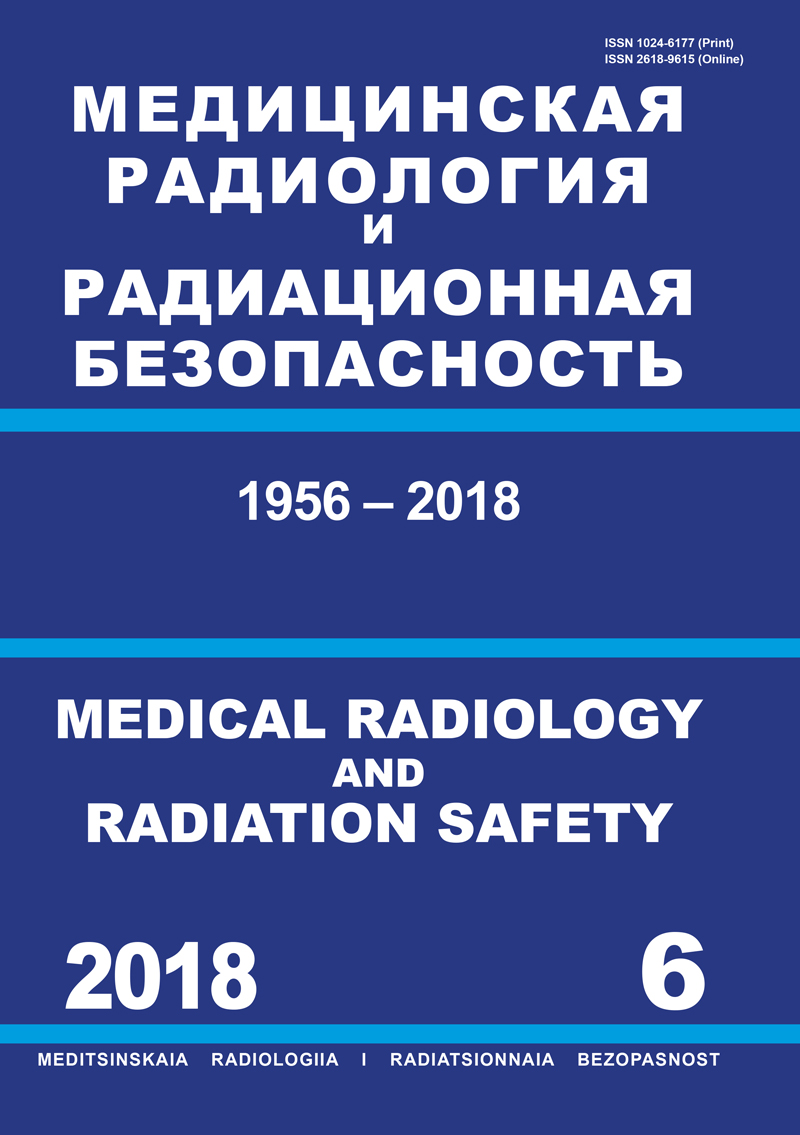Moskva, Russian Federation
Russian Federation
Russian Federation
Russian Federation
Russian Federation
Russian Federation
Russian Federation
Russian Federation
76.03
76.33
14.04.02
31.06.2001
31.08.08
32.08.12
51
534
5708
5712
5734
6212
Purpose: To compare the patterns of the relapses after the surgical and combined modality treatment of non-small cell lung cancer (NSCLC) with the postoperative radiotherapy (PORT). Material and methods: The comparative evaluation of the patterns of the relapses was carried out in 528 NSCLC patients with the IA–IIIB stage after surgical treatment (n = 174) and combined modality treatment (n = 354) using PORT in the hypofractionation regimen 3 Gy/fraction, 5 times a week, TD 36–39 Gy (EQD2 = 43.2–46.8 Gy, α/β = 3) and classical fractionation 2 Gy/fraction, 5 times a week, TD 44 Gy. Results: The local and the regional relapses developed from 2 to 59 months after treatment, most often in the first three years of follow-up (median 15 months). The local and the regional relapses were statistically significantly more frequent in the surgical treatment group (31.6 % vs 7.1 %). The frequency of the distant metastases in the both groups was not statistically different (46.6 % vs 42.3 %), however, in the surgical treatment group, the distant metastases were more often combined with the locoregional relapses (18.4 % vs 4.5 %). Surgery+PORT in comparison with surgical treatment alone reduces the incidence of locoregional recurrence at the central location of the tumor (8.8 % vs 40.0 %), peripheral non-small cell lung cancer (5.2 % vs 26.0 %), with squamous histological type of tumor (8.4 % vs 37.5 %) and in adenocarcinoma (4.6 % vs 26.4 %), regardless of the volume of surgical treatment (pneumonectomy – 7.0 % vs 47, 1 %, p = 0.0002, lobectomy and bilobectomy – 7.1 % vs 20.6 %, p = 0.001, segmentectomy – 7.1 % vs 50.0 %, p = 0.0001). In the subgroup of patients undergoing adjuvant chemotherapy and PORT, the local, regional and locoregional relapses were statistically significantly less common than in the group of non-small cell lung cancer patients who received only adjuvant chemotherapy (3.9 % vs 17.5 %, p = 0.002, 5.4 % vs 23.8 %, p = 0.001, 6.2 % vs 36.5 %, p = 0.0001). The number of combined relapses (local and/or regional relapses + distant metastases) was actually four times less in all subgroups of patients with PORT (4.7 % vs 20.6 %, p = 0.001). Conclusion: PORT as the part of combined treatment of non-small cell lung cancer statistically significantly reduces the incidence of the local, regional, locoregional and combined relapses in the squamous cell lung cancer and adenocarcinoma, central and peripheral localization of the tumor, after surgical treatment in the volume of pneumonectomy, lob-bilobectomy and segmentectomy, and when using with or without adjuvant chemotherapy.
lung cancer, surgical treatment, combined modality treatment, postoperative radiation therapy, the characteristic of recurrences
1. UICC International Union Against Cancer: Sobin LH, Gospodarowicz MK, Wittekind Ch. // In: TNM classification of malignant tumours. 7th edition. Chichester: Wiley-Blackwell. 2009:138-46.
2. Billiet C, Peeters S, Decaluwé H, et al. Postoperative radiotherapy for lung cancer: Is it worth the controversy? Cancer Treat Rev. 2016;51:417-25.
3. Vansteenkiste J, De Ruysscher D, Eberhardt WE, et al. ESMO Guidelines Working Group. Early and locally advanced non-small-cell lung cancer (NSCLC): ESMO Clinical Practice Guidelines for diagnosis, treatment and follow-up. Ann Oncol. 2013;24(6):89-98.
4. De Ruysscher D, Belderbos J, Reymen B, et al. State of the art radiation therapy for lung cancer 2012: a glimpse of the future. Clin Lung Cancer. 2013;14(2):89-95.
5. Solodky VA, Sotnikov VM, Trotsenko SD, et al. Characteristics of recurrences after surgical and combined treatment of non-small cell lung cancer. Problems in Onkology. 2017;63(4):639-44.
6. Matthews MJ, Kanhouwa S, Pickren J, Robinette D. Frequency of residual and metastatic tumor in patients undergoing curative surgical resection for lung cancer. Cancer Chemother Rep. 1973;(4)2:63-7.
7. Kharchenko VP, Chkhikvadze VD, Gvarishvili AA, Vasilyev OA. Surgical and combined treatment of non-small cell lung cancer. Vestnik RUDN. Seria Medicina. 2005;29(1):13-16.
8. Varlotto JM, Yao AN, DeCamp MM, et al. Nodal stage of surgically resected non-small cell lung cancer and its effect on recurrence patterns and overall survival. Int J Radiat Oncol Biol Phys. 2015;91(4):765-73.
9. Robinson CG, Patel AP, Bradley JD, et al. Postoperative Radiotherapy for Pathologic N2 Non-Small-Cell Lung Cancer Treated With Adjuvant Chemotherapy: A Review of the National Cancer Data Base. J Clin Oncol. 2015;33(8):870-6.
10. Su S, Scott WJ, Allen MS, et al. Patterns of survival and recurrence after surgical treatment of early stage non-small cell lung carcinoma in the ACOSOG Z0030 (ALLIANCE) trial. J Thorac Cardiovasc Surg. 2014;147(2):747-52.
11. Kharchenko VP, Chkhikvadze VD. Surgical and combined treatment of non-small cell lung cancer. Problems in Onkology. 2009;55(4):455-8.
12. Shen W, Ji J, Zuo Y, et al. Comparison of efficacy for postoperative chemotherapy and concurrent radiochemotherapy in patients with IIIA-pN2 non-small cell lung cancer: An early closed randomized controlled trial. Radiotherapy and Oncology. 2014;110(1):120-5.
13. Warren M, Webster G, Ryder D, et al. An isotoxic planning comparison study for stage II-III non-small cell lung cancer: is intensity-modulated radiotherapy the answer? Clinical Oncology. 2014;26(8):461-7.





